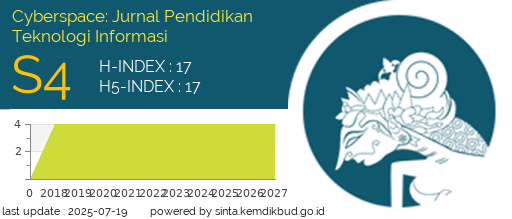PENGEMBANGAN MEDIA PENGENALAN KAMPUS UIN AR-RANIRY BERBASIS VIDEO 360 DERAJAT MENGGUNAKAN VIRTUAL REALITY
DOI:
https://doi.org/10.22373/85c56870Keywords:
Introductory media, UIN Ar-Raniry, 360-degree video, interactive, Research and Development (R&D)Abstract
The purpose of this study is to replace the less effective method of drawing plan media as a campus introduction medium for visitors to UIN Ar-Raniry Banda Aceh. With digital technology increasingly developing, smartphone use can be directed to profitable activities, such as watching videos on YouTube. This 360-degree video was made to introduce the layout of the UIN Ar-Raniry campus building more interesting and interactive for visitors. This study uses research and development research methods and involves 50 visitors to the UIN Ar-Raniry campus as respondents. The results of the evaluation showed that 100% of media experts rated this 360-degree video as very feasible as a campus introduction medium, while visitor responses showed an average of 96,4% in the category of "Very Good". The high video resolution, ease of operation, and clear explanations in each building that is passed make this 360-degree video effective in increasing the final understanding of UIN ar-raniry. With positive responses from experts and visitors, this 360-degree video has great potential to be used as an innovative and interesting campus introduction medium, helping UIN ar-raniry students understand the layout of the campus building in a more interactive and fun way.
References
[1] Y. Anggara and G. M. Zamroni, “Virtual Reality Tour Menggunakan Metode Gambar Panorama 360° Sebagai Media Informasi dan Pengenalan Gedung Perkuliahan Kampus 4 Universitas Ahmad Dahlan,” JSTIE (Jurnal Sarj. Tek. Inform., vol. 9, no. 1, pp. 1–12, 2021, doi: 10.12928/jstie.v1i1.19045.
[2] Anang Wijaya, H. A. Musril, R. Okra, and K. Khairuddin, “Perancangan Virtual Reality Tour Sebagai Media Informasi Tata Letak Gedung Kampus Ii Iain Bukitinggi,” J. Teknol. Inf. J. Keilmuan dan Apl. Bid. Tek. Inform., vol. 17, no. 1, pp. 9–19, 2023, doi: 10.47111/jti.v17i1.5518.
[3] Mona Triana, “Media Massa dan Public Sphere,” J. Sci., p. 4, 2022.
[4] Y. Gule, A. J. Laratmase, C. Sholihin, R. Riztya, and S. F. Rahmani, “Pengelolaan Media Informasi dalam Pembelajaran untuk Penguatan Perilaku Religiusitas Siswa di Sekolah Dasar,” J. Educ., vol. 5, no. 4, pp. 13315–13323, 2023, doi: 10.31004/joe.v5i4.2332.
[5] H. T. T. Saurik, D. D. Purwanto, and J. I. Hadikusuma, “Teknologi Virtual Reality untuk Media Informasi Kampus,” J. Teknol. Inf. dan Ilmu Komput., vol. 6, no. 1, pp. 71–76, 2019, doi: 10.25126/jtiik.2019611238.
[6] S. AS and D. Kustono, “Potensi Penggunaan Teknologi Augmented Reality (AR) dan Virtual Reality (VR) dalam Pembelajaran Sejarah Arsitektur di Era Pandemi Covid-19,” Jupiter (Jurnal Pendidik. Tek. Elektro), vol. 7, no. 1, p. 10, 2022, doi: 10.25273/jupiter.v7i1.12262.
[7] S. R. Siahaya, “Literatur Review: Penerapan Virtual Reality sebagai Media Pembelajaran Interaktif,” Bul. Ilm. Ilmu Komput. dan Multimed. …, vol. 2, no. 2, pp. 313–319, 2024, [Online]. Available: http://jurnalmahasiswa.com/index.php/biikma/article/view/1260%0Ahttp://jurnalmahasiswa.com/index.php/biikma/article/download/1260/871
[8] H. R. Raehana, “360° Photo Techniques and Virtual Reality in Cinematography,” Arty J. Seni Rupa, vol. 11, no. 2, pp. 56–63, 2022, doi: 10.15294/arty.v11i2.56111.
[9] D. Satrio and A. Muhardono, “Virtual Tour Berbasis Website Sebagai Pendukung Media Pemasaran Kampus,” J. Minfo Polgan, vol. 12, no. 1, pp. 289–296, 2023, doi: 10.33395/jmp.v12i1.12372.
[10] T. Wibowo and E. Lee, “Perancangan dan Implementasi Video 360 Di SMK Harmoni Batam Menggunakan Metode MDLC,” Natl. Conf. Community Serv., vol. 4, no. 1, pp. 866–873, 2022.
[11] Y. Fitriyah, “Virtual Hospital Video 360 Sebagai Media Interaktif-Promotif di Rumah Sakit Pratama Kota Yogyakarta,” J. Inf. Syst. Public Heal., vol. 8, no. 1, p. 32, 2023, doi: 10.22146/jisph.72042.
[12] D. P. A. Pratama and N. C. Sakti, “Pengembangan Media Pembelajaran Handout Digital Berbasis Android,” J. Pendidik. Ekon. Undiksha, vol. 12, no. 1, p. 15, 2020, doi: 10.23887/jjpe.v12i1.25327.
Downloads
Published
Issue
Section
License
Copyright (c) 2025 Naufal Maulana

This work is licensed under a Creative Commons Attribution-ShareAlike 4.0 International License.
Authors who publish with Cyberspace Journal agree to the following terms:
- Authors retain copyright and grant the journal right of first publication with the work simultaneously licensed under a Creative Commons Attribution License that allows others to share the work with an acknowledgement of the work's authorship and initial publication in this journal.
- Authors are able to enter into separate, additional contractual arrangements for the non-exclusive distribution of the journal's published version of the work (e.g., post it to an institutional repository or publish it in a book), with an acknowledgement of its initial publication in this journal.
- Authors are permitted and encouraged to post their work online (e.g., in institutional repositories or on their website) prior to and during the submission process, as it can lead to productive exchanges, as well as earlier and greater citation of published work (See The Effect of Open Access).


















